from Kinja.com
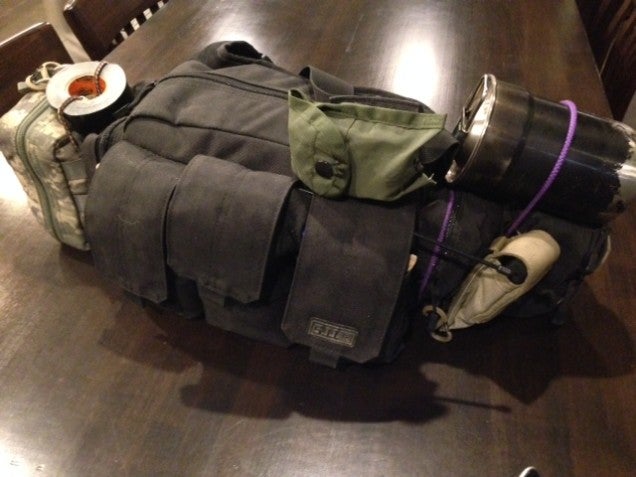
Most of our go bags only borrow the name, featuring the things we like to carry on a regular basis. Reader Scott Kelley takes his gear a little more seriously and has a “bug out bag” system that’s versatile and geared towards survival.
Scott posted a ton of detail on his Kinja blog, so rather than summarizing it and missing out on much of the good stuff, we’re republishing the whole post here. Check out everything he’s currently doing below.
If you have a great go bag with a useful organization scheme and great features, let us know! You can share your bag by posting it to your personal Kinja blog using the tag featured bag or adding it to our Lifehacker Go Bag Show and Tell Flickr pool. Photos must be at least at least 640×360. Please include information about your bag, what you put in it, and any relevant details about how you made it awesome. If yours catches our eye, we might just feature it!
What’s in your bug out bag?

There are a lot of different things you can put on your bug out bag list and there’s not really one list of contents that you should follow. Each item in your kit will depend on your skill set and what you’re trying to prepare for. It’ll also change depending on your region, the season and how likely it is that you’ll have other gear available to you while you’re out.
I’m currently redoing my whole kit so I figured I’d let you know what I currently have and then update you with how I change things. At least this way you’ll have a decent idea of what one way is to pack a bugout bag.
Currently, I have my system in five (six) major parts:
- My EDC kit that I have with me every day
- A go bag that has enough items to survive for a short time (the bag in this article)
- A main pack that has backup items and more comfort
- An INCH bag (I’m Not Coming Home) that has quite a bit but I wouldn’t want to carry it very far
- A vehicle kit in my car, including car emergency kit
- My motorcycle EDC kit
I live in Phoenix, AZ so my kit will reflect that. Especially with the snow recently throughout the rest of the country, my pack would be absolutely different if I didn’t live here.
Today, I’m just going over what’s in my go bag. You could also call it a bugout bag but that gets confusing with my main pack so I changed their names. It’s really a question of semantics anyway. I purposely kept it small and light and can easily pull out a couple things If I really need to. It’s not a full-on 72 hour bag that you may expect unless you combine it with the backpack.
I’m in good shape overall for an old dude that started off the Army in the Cold War (usually run my Army 2 mile in the 13’s or 14’s) but I don’t hike or run as much as I really need to.
Without water, my pack is about 13-14 pounds and I carry 96oz of water in it for a total of about 20 pounds wet, plus my EDC and whatever else. My go bag has items I’d need to survive for a short time. It could also be a get-home bag really, depending on where I’m at when I first need it. It has a survival kit and medical kit in it. It’s designed for temporary self-rescue because when I’m expecting to be somewhere that I’d have to live in the bush for a while, I’d bring my main pack or my INCH bag if I could. As with everything, it’s a compromise. I could live off just the pack if I really needed to but it wouldn’t be optimal. Much better than being caught with just my EDC though.
Since I’m redoing my main pack to support search and rescue with the Sheriff’s Office better (the current most-likely scenario that I’d find myself having to survive on my own for a few days, if I get separated during a search somewhere until they come get my dumb ass), I’ll post that in a separate article later. Then you can see how the system all fits together. Your bugout kit should be a bugout system, starting with your EDC and working its way up to everything you have at your bugout location and have stashed along the way.
This is a real-time snapshot of what’s actually in my pack as I’m sitting at Starbucks drinking my Zen tea. As you’ll see, because I haven’t gone through the thing from scratch in a while, it’ll need some adjustments here and there.
The bugout bag itself
Currently, my pack is a 5.11 bail out bag. I chose it because it’s a shoulder bag. This allows me to add a backpack without it getting in the way and also reach my weapon. This bag is super tough and pretty much the perfect size but I’ll be changing it at some point. I’d like to carry just a tad more (I’m not really a fan of hanging anything outside of the bag unless it’s something secured tightly and I need it immediately like ammo). It’s also a bit too tactical-looking for my taste so it makes me stand out as it is. In 99% of cases, that doesn’t make any difference and may even be an advantage in certain scenarios. If I were caught on my own in a societal collapse or similar, it could be a problem. In that case, I’d drape a light jacket over it on my shoulder and start looking for an acceptable replacement. In the meantime, I’ll wait until I find just the right bag. It’s hard to find a rugged incognito bag in the right size that isn’t several times more expensive but you always need to be improving your fighting position. This one works for now and isn’t designed for fully bugging out by itself anyway but I could if I had to with it.
 Expand
Expand
Bug out bag contents – outside
So what’s in the bag? First, let’s look at what’s on the outside of the bag.
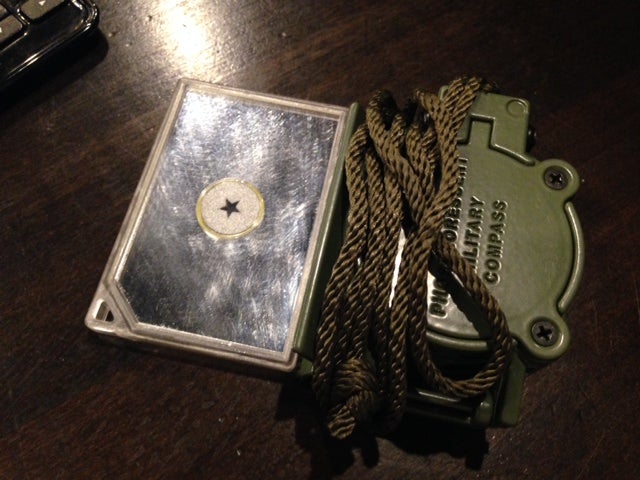 Expand
Expand
I’ve attached a compass pouch to the shoulder strap. This pouch holds my Army-issued tritium lensatic compass and a rescue mirror.
On the zipper pulls, I have: A figure 9 caribiner to tighten a 550 cord for a shelter. I lost a few of them so I need to get more. Having 2 is pretty nice to tie up a tarp for a small shelter. A small keyring flashlight that came with one of my care packages I got in Afghanistan is attached to it.
A few small S-biners to clip things to.
Strapped onto the bag with a couple of bungee cords are:

 A 24oz Stanley steel cooking cup. Having something you can heat up water on a fire with is important. I’ve removed one of the two cups inside (it’s for survival, not for camping so I don’t really need two. This drops the cup from about 13.8oz weight to about 10.8oz. This also allows me to fit a few items inside, including:
A 24oz Stanley steel cooking cup. Having something you can heat up water on a fire with is important. I’ve removed one of the two cups inside (it’s for survival, not for camping so I don’t really need two. This drops the cup from about 13.8oz weight to about 10.8oz. This also allows me to fit a few items inside, including:
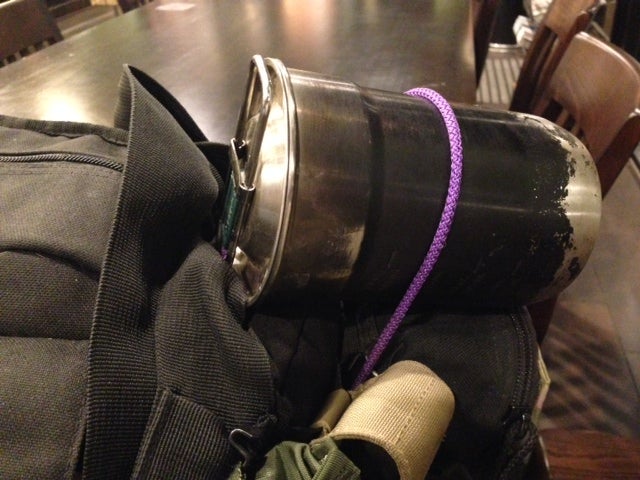 Expand
Expand
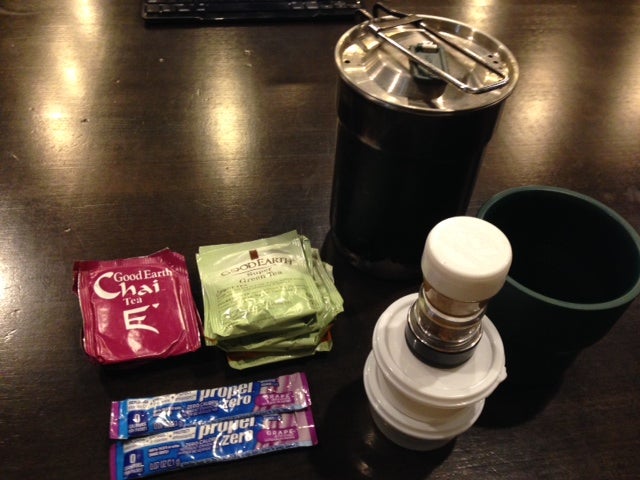 Expand
Expand
-
- Several tea bags
- A couple of propel zero water flavor packs just because water gets boring after a while.
- A couple of small round containers I got from the 99 cent store. One of them has sugar and the other one is empty at the moment but I have it in there because it fits and weights almost nothing. I trimmed the little lip tab off the bottom one so it fits flat in the cup.
- A camping salt and pepper shaker with a mix of salty seasonings on one side and pepper/curry type of seasonings in the other; a trick I learned a long time ago to help MRE’s taste better. They really sucked when they first came out.
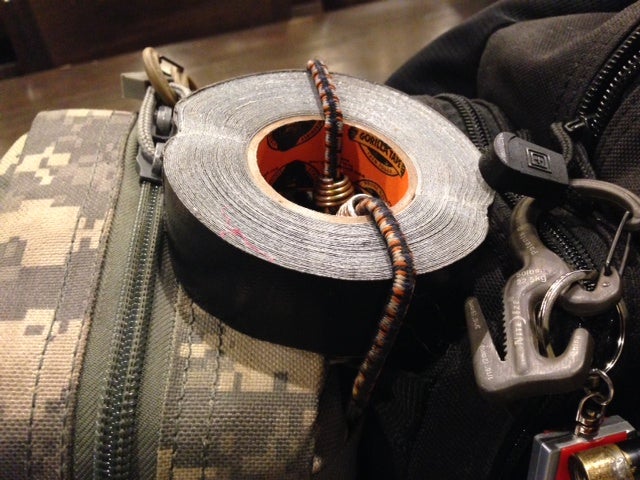 Expand
Expand
- A roll of black gorilla tape (duct tape).
As I’m going through this, I notice that my earplugs aren’t attached to the bag so I’ll have to find them. They’re great for sleeping in a noisy environment or saving your ears in a gunfight. I’m also missing my sleeping eye cover thingy. Sometimes you need to sleep in the daytime and move at night and that really helps. Plus, it weighs almost nothing and fits anywhere.
Strapped to the molle on the outside of the bag is: A Gerber multi-tool that came with one of my Army weapons cleaning kits a few years ago.
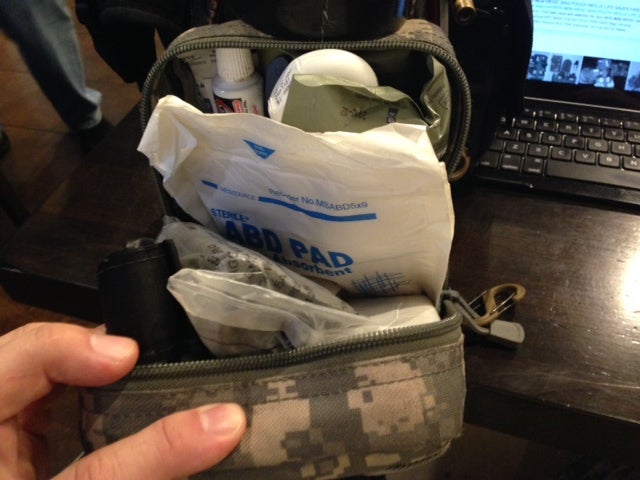 Expand
Expand
An older Army-issued IFAK (Improved First Aid Kit) is strapped to one end of the bag. I’ve swapped out a few items in it and added things like:
- 50m of dental floss. Good for cleaning your teeth, fishing line, or just thin cordage.
- Two QuikClot combat gauze packs
- Two tubes of Clotrimazole (invaluable for foot rot or a sweaty nether region). I got pretty much put out of commission in Central America one time due to walking through the jungle for a couple of days. This stuff cleared me up in just a few hours. I always carry it now.
- 0.5oz neosporine for cuts.
- 1oz Banana Boat 30spf sunscreen. Try to get the sports kind so it’s sweat-resistant like this stuff.
- Combat Application Tourniquet (CAT). I was issued this one in Afghanistan. The big thing to look for is something like this that you can put on one-handed in case you have to put it on yourself.
- A couple of sterile disposable safety scalpels I picked up in Afghanistan. I doubt I’d really need a scalpel for medical use but they could come in handy for other uses.
- A couple of 3-0 monofilament sterile 18″ sutures. These might be super useful if you need to close up a pretty big gash to get someone to a medic. You could also use them to sew up your clothes if you needed to.
- A flattened roll of moleskin (half the roll). Blisters can stop you so having something like this is super important.
- A few packs of butterfly sutures. These are good for small gashes.
- Two pairs of medical gloves. You need to change these out occasionally because they’ll break down just sitting in your pack.
- I see I’m somehow missing my medical scissors so I’ll have to get one of those. The TSA allows you to fly with some scissors in some cases so I need to find a good pair that I could carry with me as I travel. I’m seriously considering getting the Leatherman Raptor.
 On the other end, I have a small molle pouch that fits just right without being too bulky. In this pouch, I keep:
On the other end, I have a small molle pouch that fits just right without being too bulky. In this pouch, I keep:
A 12v charger for the ham radio I have in the bag. I have the radio and power supply in separate bags because that’s how they fit best but I don’t really like doing that. One of the things I’ll be doing when I redo this bag is putting them in the same location.
Two spare AA batteries for the flashlight in the bag. My main pack has a solar charger for rechargeable batteries but I have two non-rechargeable ones in this bag because they hold their charge longer when not being used.
One pack of 2400 calorie U.S. Coast Guard survival pack food. This fits pretty well in the pouch.
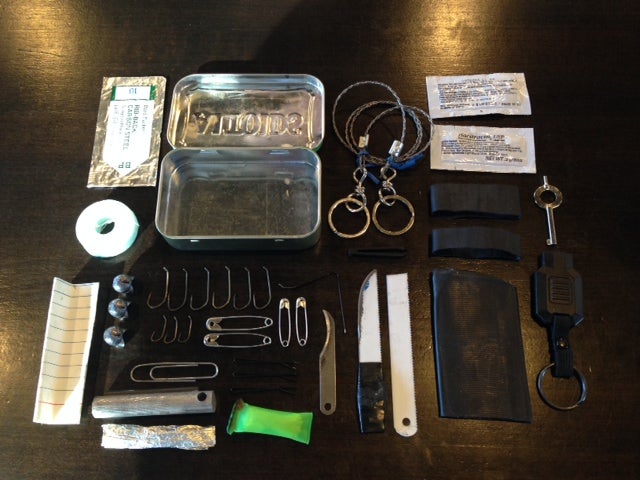 Expand
Expand
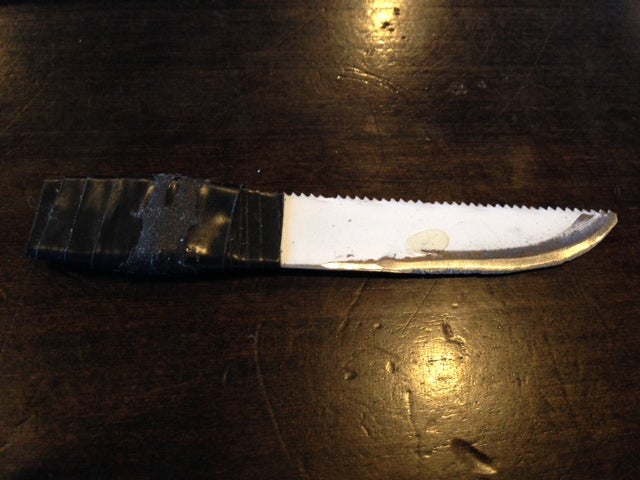 Expand
Expand
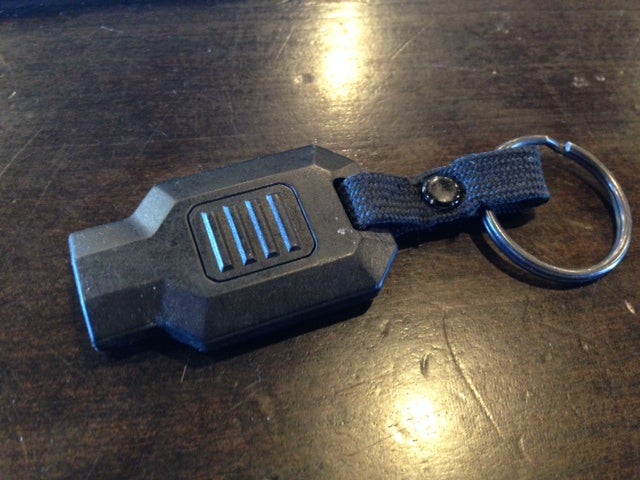 Expand
Expand
My Altoids tin survival kit. This kit includes:
- Two ranger bands to hold it together, which is just a couple of bands cut from a bicycle inner tube. One 3″ or so ranger band on the inside.
- Four Tinder-Quik fire tinder tabs that have been put into a cut straw sealed on both ends. I still need to seal a few more for this kit overall. I don’t like having all of one thing in the same place but I haven’t had a chance to make more sealed ones. I have some unsealed ones in the rest of the bag though.
- A survival saw that I replaced the loops with a couple of smaller keyrings.
- A Maxi-Match ferro rod with magnesium firestarter.
- A flat keychain flashlight with red LED. I didn’t specifically choose red for this but it fits better than my white ones do. Doesn’t hurt to have a red one I guess.
- A tiny pair of plastic tweezers I got out of one of those little wallet credit card multi tool kits.
- Spool of waxed dental floss, removed from the case.
- A piece of aluminum foil wrapped around a safety pin that’s wrapped with some dental floss. You can start a fire with a thin strip of aluminum foil wrapped with paper or tinder by touching the ends either to the posts of a 9v battery or putting two AA batteries end to end. The trick is to get the right with of a strip. Too thin and it’ll either break or burn out too quickly. Too think and it won’t heat up enough.
- A few fishing sinkers.
- Part of a hacksaw blade that’s been sharpened into a small knife and its handle wrapped in tape (see pic above).
- Another part of a hacksaw blade that’s not been sharpened.
- A size 10 surgical blade.
- Two packs of bacitracin antibiotic ointment.
- A 3″x5″ card. Good for tinder or leaving a note.
- One concave X-Acto blade.
- Two small and two medium safety pins.
- Medium paperclip.
- Four hairpins, one pre-folded for picking handcuffs.
- One handcuff key.
- Three tiny and six small fish hooks.
Inside the bag
The bag itself has a main pocket, three front ammo pockets, and a pocket on each end.
 Expand
Expand
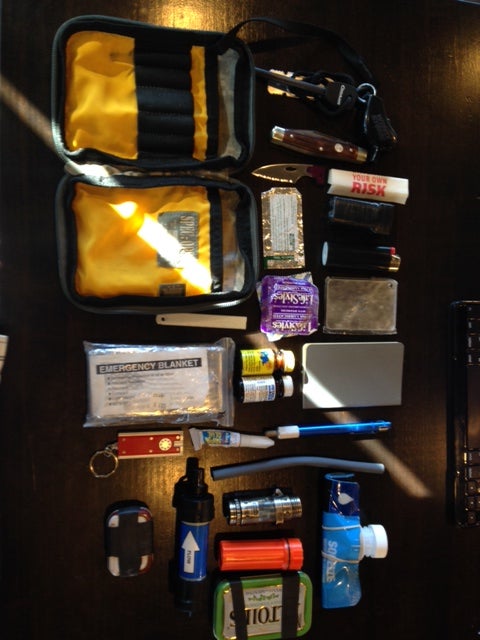 Expand
Expand
In the first end pouch, I have:
- A Sawyer Mini water filtration kit minus the cleaning syringe. Which is awesome.
- A Coleman waterproof match case with a piece of sandpaper and assortment of matches.
- A Brunton Firelight. I like this one because it has a windproof flame on one end and a tiny LED light on the other.
- A mini Altoids tin with an assortment of fish hooks, safety pins, fishing weights, a concave X-Acto blade and some aluminum foil. It’s held closed with a couple of ranger bands.
- A Spec-Ops mini organizer that contains the following:
- A small disposable lighter.
- A Wind-Storm safety whistle.
- A cheap, one-time use crappy emergency blanket. I’ll be changing to a better one
 soon that doesn’t tear as easily as these crappy things do.
soon that doesn’t tear as easily as these crappy things do.
- A Rescue Flash signal mirror.
- A size 10 surgical blade. Hey, I had a few of these left over from my last deployment and they don’t weigh anything or take up any room, so why not?
- A section of hacksaw blade.
- A piece of thin paper from an Altoids tin for tinder.
- Two prophylactics. You never know.
- A small Moleskine notepad.
- The blade out of a credit card wallet kit.
- Portable Aqua water purification tablets.
- Another one of those little flashlights I got in a care package in Afghanistan.
- A 9V battery and infrared beacon all wrapped in tape. It’s IR because that’s what they issued me but it could come in handy sometime. Besides, I take a good deal of this stuff when II go on missions. I wouldn’t mind getting a white light strobe or flashlight for the 9v too.
- A Smith’s diamond retractable knife sharpener.
- .07 ounce tube of super glue.
- A small wooden pocket knife.
- A Coghlan’s flint striker.
I’ll be adding some potassium permanganate to the kit as soon as I figure out exactly how I want to carry it and what I want to use with it. It’s great for starting a fire, even in bad weather. Here’s a video to show you what it can do:
In the side pocket of the other side of the 5.11 bag, I have:
- A Rite in the Rain all-weather notebook. I’ve apparently lost the Fisher space pen that I had with it so I’ll have to get another. They’re kinda pricey but I really like them. I always have one in my pocket.

 A roll of Charmin To-Go toilet paper. It’s in its own plastic container but I really need to seal it with tape. Wet TP isn’t very useful. Dry stuff is great for its intended use as well as tinder. It would work well with the battery/aluminum foil trick.
A roll of Charmin To-Go toilet paper. It’s in its own plastic container but I really need to seal it with tape. Wet TP isn’t very useful. Dry stuff is great for its intended use as well as tinder. It would work well with the battery/aluminum foil trick.- A kitchen sponge (good for soaking up dew off of plants to get some water).
- A 1 oz container of Gold Bond body powder.
- A Yaesu VX-6R handheld ham radio.
In the main pocket, I have:
- A Fenix LD-10 flashlight (takes a single AA battery). Great little light.
- A small Commando brand jewelry screwdriver kit.
- A small roll of 550 cord.
- An Army-issued poncho wrapped in a large bungee cord. This is the type that has snaps so it works really well as a poncho but you can use it as part of an emergency shelter.
- A thumb drive that gots all my pertinents n such.
- A hot weather vented boonie hat.
- A 5’x7′ emergency tarp. Not a great tarp but it folds up small and doesn’t weigh too much.
- A titanium spork.
- Four 24 ounce bottles of water (about 5 pounds worth).
The three ammo pockets in the front contain:
- A Diamond SRH77CA antenna for the ham radio that sits across all three pockets, under the flaps.
- Another wad of 550 cord.
- Five large bungee cords.
- A pair of gloves.
- A Neck Gator. Seriously, this is one of the greatest things I ever got from the Army. In a lot of cases, all I needed to go from shivering to comfortable is one of these. They make them in different thicknesses too.
- Pair of socks.
- A knitted watch cap.
- 3 oz Banana Boat 30spf water-resistant sunscreen.
- Four Gatorade 01 Prime workout bars (200 kcal ea).
- Five Clif Bars (240 kcal ea).
So as you can see, it’s still (and always) a work in progress. I really want to try to keep all the survival stuff in one section and medical in another etc but it’s kinda hard to make that happen. I have it set up though so that if I had to drop the pack, I can reach in for a few things quickly. I’d rather have it so I didn’t have to think about what I wanted to grab. 20 pounds doesn’t sound like much but it gets heavy after a while, especially if you add extra water or other gear.
What’s in your bug out bag?


 Expand
Expand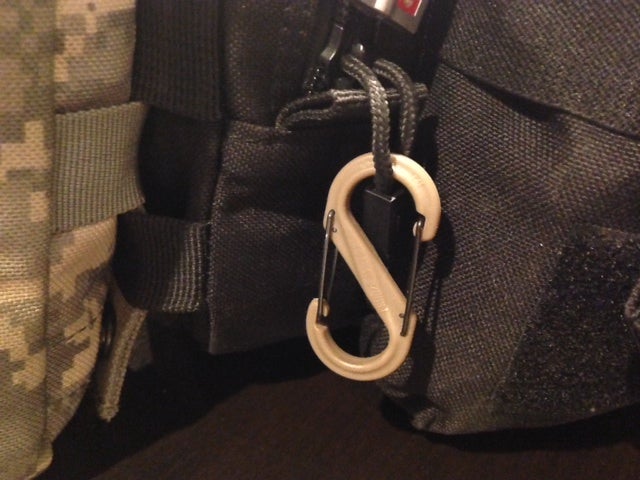 Expand
Expand